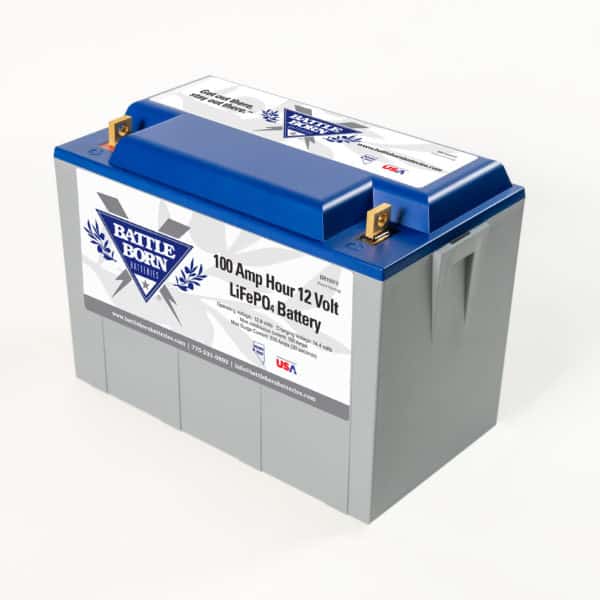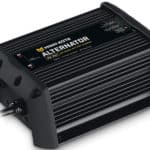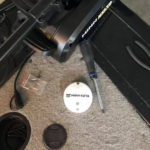If you run an electric trolling motor, it would not be a stretch to say that your batteries consume a significant amount of your time and money. Between maintaining the water levels and checking wires because of voltage drop damage, the maintenance never stops.
Next, If your battery lasts ten times as many trips for less than four times the cost, you could save some serious money. These and more benefits are available if you are willing to put a little cash out front for a lithium trolling motor battery.
First, we will learn a little about lithium trolling motor batteries and then review five of the best-selling drop-in lithium-ion deep cycle batteries.
Note: most links in this article are Amazon.com Affiliate links, see Affiliate Disclosure, thank you.
Overview
Lithium-ion batteries have come into their own over the last few years. Metal, lithium, is the main component of these batteries that make up the battery’s anode.
Other metals or chemical compounds are added to the battery to make up the battery’s cathode portion. The most popular of these compounds is iron-phosphate for a few reasons that we will cover, including safety.
For this article, we are going to focus on user-friendly drop-in LiFePO4 batteries. These batteries will fit into most boats, and with a few changes, it will be a smooth transition.
What is a lithium-ion drop-in battery?
As mentioned in the overview, lithium-ion drop-in batteries are safe and user-friendly. Because of that, you can drop them in your boat and go fishing in most cases. What makes these batteries, so user-friendly is that they connect the same way a standard AGM or gel deep cycle battery and have a BMS that controls the cell operation.
The BMS (battery management system) controls cell voltage levels and can control other operating issues like low or high voltage cutoff and over or under temperature problems. Effectively, the BMS is more of a safety system to maintain your battery by constantly checking it.
Can I charge my lithium-ion drop-in battery with my current charger?
Drop-in lithium-ion batteries don’t require any specific lithium batteries charger. Because of the BMS, they prefer a particular charge profile of bulk stage or bulk and absorption stages for complete charging. A single or two-stage smart charger will work well in most lithium-ion drop-in batteries.
Single-stage chargers provide bulk charging, which can provide most lithium-ion batteries a 97% charge. In contrast, a two-stage charger can bring most lithium-ion drop-in batteries to 100%. Most battery experts say that it is always better to error on the side of undercharging and that you should expect more charge cycles from your battery if you slightly undercharge it.
In most cases, if your charger is set to charge an AGM or gel battery, you should be fine but check with the manufacturer to be sure.
How many charge cycles does a lithium-ion drop-in battery have?
By far, the most significant advantage to a lithium-ion battery is charge cycle life. A standard lithium-ion battery with a BMS can be cycled 2000 times or more. Think about that, 2000 full day fishing trips.
A high-quality AGM lead-acid battery can only cycle 500 times to 50% power, on average. A gel battery can be cycled more time at a deeper depth of discharge, while an old fashion flooded lead acid will be lucky to get 300 cycles.
As technology advances, we see manufacturers putting out drop-in lithium-ion batteries that are warrantied for 3000 charge cycles and claim to get 5000 cycles at 80% capacity. 5000 charge cycles is roughly fishing every day except holidays for 14 years, wow! Or, you could fish every weekend for 50 years and never replace your batteries.
How long will drop-in lithium-ion batteries hold a charge?
Drop-in lithium-ion batteries lose about 1% charge per month and as they age slightly more. If you could charge a drop-in lithium-ion battery 100% and let it sit to 0%, that would be eight years. Now you can’t discharge a lithium battery to 0% without damaging it, but a 50% charge level will be just fine. So, letting your batteries sit a few months out of the winter should be ok.
What position can I mount drop-in lithium-ion batteries?
A great feature of most lithium-ion batteries is that they can be mounted in any direction, including upside-down. When you compare that to flooded lead-acid batteries, that will spill their acid electrolyte when bumped or tips slightly, this is a vast benefit, especially in boats and ATVs.
How much do drop-in lithium-ion batteries weigh?
The average weight of a 100 amp hour drop-in lithium-ion battery is just under 30 pounds. Most of the weight is attributed to the lithium-ion cells. Additional weight is added for the case, wires, BMS, and any extras like USB charge ports.
A similar 100 amp-hour AGM battery can weigh 70 pounds, making it more than double the weight of a drop-in lithium-ion battery.
Other advantages of drop-in lithium-ion batteries?
A lead-acid battery has a big issue with the depth of discharge, and a quality AGM battery can only be discharged to 50% without damage. If you have a 100 amp hour battery, it can only net you 50 amp hours.
Drop-in lithium-ion batteries can give you almost 95% of the total amp-hour, a 100 amp hour battery to net you nearly 95 amp-hours. If you want to think about that in terms of money, you can buy one battery rather than two batteries.
While using the battery, another critical performance for lithium-ion batteries is that the volt is almost constant. When you are using your battery, it will be at a voltage of 13.6 volts most of the time.
The final advantage of note is wire sizing. Because your battery’s voltage is constant, you can use the minimum rated wire gauge and breakers for your motor’s amperage.
As a lead-acid battery uses amps, the voltage decreases, and the amperage increase, resulting in heat causing more electrical performance issues, but not with lithium-ion batteries. Technically speaking, a battery with a BMS also has a short circuit disconnect built-in, so you would not need a fuse or breaker, but it is still the best practice and ABYC wiring code.
Drawbacks of drop-in lithium-ion batteries?
After reading about so many advantages, you may think there are no drawbacks to lithium batteries, but I am sorry to say that you are wrong. The most significant and foremost disadvantage of lithium batteries is their price. Even the cheapest ones may be a bit too much for your budget.
On top of the battery price, you may need to purchase a new charger, so don’t forget to add that to the cost. So, is it worth putting the money upfront for lithium batteries? Well, that depends on your needs. If you want a long-lasting battery that is super durable, then I must say that lithium batteries are best for your needs.
Not all BMS are created the same in every drop-in lithium-ion battery. The main concern should be if you can wire multiple batteries in series or parallel. Series wiring is a big issue for 24 volt and 36 volt trolling motors, so check with the manufacturer before purchasing.
Finally, the temperature is the last topic that we need to cover. Most lithium batteries cannot be charged below freezing, or you will damage them beyond repair. Additionally, high temperatures can also damage your battery. Many BMS have temperature sensing built-in and will shut the battery down, protecting it, and reset when it is safe to use.
Now that we have learned about lithium batteries, let’s look at the 5 top drop-in Lithium Trolling Motor Batteries Reviewed on the market today. So, without any further delay, let’s get started.
Product overview
Best overall lithium-ion drop-in battery
Battle Born 12v 100Ah LiFePO4 Deep Cycle Battery
Best budget-friendly lithium-ion drop-in battery
Ampere Time 12V 100Ah 1.28KWh Lithium Deep Cycle Battery
Lowest Price lithium-ion drop-in battery(at time of the article)
Chins 12V 100Ah LiFePO4 Deep Cycle Battery
Battle Born LiFePO4 Deep Cycle Battery 100Ah 12v

This Battle Born battery is designed and assembled in Reno, NV. This LiFePO4 – lithium iron phosphate deep cycle battery is excellent for use in an RV, Boat, or Off-grid power system. It is considered as one of the best of its kind in the market. Because this battery can be wired in series to make 24 volts, 36 volts, and 48 volts, it is a great option.
Pros:
- Built-in BMS(Battery Management System)
- Low and high-temperature protection
- 100 amp continuous output
- 50 amp charge rate recommended, 100 amp max
- Lightweight(29 pounds 2021) and compact (group size 27)
- 3000 charge cycles
- 10-year warranty (3-year full replacement)
Cons:
- Price
We were impressed by the longevity of this product. Current lab testing shows the battery at approximately 80% capacity remaining available after 3000 cycles. You can use it for years without any additional maintenance costs.
It doesn’t generate any hydrogen gas like lead-acid batteries, making it entirely safe for use indoors. It also has a reasonably shorter charging time. Its price may seem a bit too much, but you won’t regret it if you are buying this.
Note: while the price may seem a little high, we have seen all lithium batteries decreasing in price over last year, including Battle Born Batteries.
Click here to check the price on Amazon.com
We normally don’t put other people’s YouTube videos on our articles however this one is worth a few minutes of your time.
Renogy 12V 100Ah Smart Lithium Iron Phosphate Battery

The Renogy Smart Lithium Iron Phosphate Battery enables auto-balance among parallel connections and provides more flexibility for battery connection thanks to its RJ45 communication ports. If you’re searching for a deep cycle battery for RV, cabin, or marine use, then this lightweight, auto-balanced, ultra-safe, long-cycle-life lithium-ion battery is the perfect plug-and-play solution for you!
Pros:
- 100Ah rated capacity
- 12.8 V nominal voltage
- Auto balance among parallel-connections
- BMS(Battery Management System)
- Lightweight and compact
- Built-in communication port
- 6-year warranty
Cons:
- Price
- Cannot be connected in series for 24 volt systems
We just loved the design and features of this battery. They have designed in a Phillips screw approach to attaching flat-ring-end cables, eliminating the awkward moves necessary with the old wrench style of cabling. Short charging time and 26lb machinery add to its greatness.
One big drawback of this product is that it cannot be connected in series for 24 volt systems. This is a problem if you have a 24 or 36-volt system.
Click here to check the price on Amazon.com
Ampere Time 12V 100Ah 1.28KWh Lithium Deep Cycle Battery

This Ampere Time battery can be mounted in series or parallel, and they can replace the traditional lead-acid, AGM, or gel batteries. It weighs about 60% of a regular AGM or gel battery, and it has a six times faster-charging capacity. It is more stable at high discharge current and high or low temperatures.
Pros:
- 100Ah rated capacity
- 12.8V nominal capacity
- Series connection of up to 4 batteries
- 4000 to 8000 charge cycles
- Lightweight (25 pounds)
- Built-in protection from overcharging and discharging
- Built-in BMS(Battery Management System)
- 5-year warranty
Cons:
- Newer brand – limited history
Ampere Time batteries have worked hard on making this product perfect for their customers. Like every other lithium battery, it is also renowned for its longevity. It doesn’t require maintenance and charges at 100 amp, making it faster than most batteries.
Additionally, the Ampere Time battery website says you can connect four of their battery in series. Doing so will make a 48-volt battery capable of powering an extensive solar system or use three batteries for a 36 volt trolling motor.
Finally, if this battery had more history, we might be able to rate it as best overall. Keep an eye on customer comments, and we will update this every month or so.
Click here to check the price on Amazon.com
ExpertPower 12V 100Ah Lithium LiFePO4 Deep Cycle

The ExpertPower battery’s proprietary lithium-iron-phosphate chemistry takes the hassle out of maintaining the battery and utilizing the power you need. It is regarded as one of the best lithium batteries in the market.
Pros:
- 100Ah rated capacity
- 12.8V nominal capacity
- Series connection of 2 batteries for 24 volts
- 2500-7000 cycles of life
- Built-in BMS(Battery Management System)
- Impeccably lightweight (23 pounds)
- 10-year warranty
Cons:
- Price
- 70 amps max draw
This is one of the best products because it has a better price than most other batteries. The ExpertPower 12V 100Ah Lithium is capable of connecting two batteries in series for 24 volts, making it possible to use with most medium-size electric trolling motors. Its durability and improved design are just perfect for running a trolling motor. We haven’t noticed any mentionable downsides in this product except its price.
Click here to check the price on Amazon.com
Chins 12V 100Ah LiFePO4 Deep Cycle Battery

This Chins Battery is perfect for use in small boats, kayaks, and canoes. High power BMS (Battery Management System) will protect the battery from being over-charged, discharged, or even short-circuiting. This feature regulates the amount of power being utilized and serves as an automatic shut-off system to protect the Lithium-Ion (LiFeP04) cells.
Pros:
- price
- 100Ah rated capacity
- 50 amp maximum charge rate(20 recommended)
- 12.8V nominal capacity
- lightweight
- 3 year warranty (replacement after testing)
Cons:
- 2000 charge cycles
- Newer brand – limited history
Without hesitation, this battery is the lowest price with good specifications and verified user reviews. The BMS in this battery allows for a four battery series connection for a maximum voltage of 48 volts. There is a little missing information as far as low and high-temperature protection.
The price might have some relation to the 2000 charge cycle rating, which is 33% lower than most lithium batteries. However, there appears to be no chemistry difference for the Chins 12V 100Ah LiFePO4 Deep Cycle Battery and other prominent manufacturers’ drop-in batteries.
Finally, if this battery lasts the test of time, we think this battery might move up on our list.
Click here to check the price on Amazon.com
Top lithium-ion drop-in battery charger
When you switch to a lithium battery, there is a chance that your current charger will not be a good match or safe to use with your expensive new battery
Victron Energy Blue Smart IP67 12/24-Volt 5-25 amp Battery Charger (Bluetooth)

We love the Victron company in general; every product we have ever purchased has been great and stood the test of time. I am currently using a Victron battery monitor in the boat, and a charge controller in the grid storage shed. When using a single battery (12 or 24 volt), Victron is an easy choice.
Pro:
- Fully Bluetooth programmable
- Available in 12 or 24 volt
- Available in many amp ratings
- Fully compatible with other Victron products
- waterproof
Con:
- Single battery connection
- Maximum 25 amps at 12 volts (or 12 amps at 24 volts)
The Victron IP67 charger is not a boat battery charger, but it will fit the job perfectly because it is heavy-duty and waterproof. A 25 amp charger will work perfectly for most batteries, even though many lithium batteries have a higher max charge rate.
Besides the Victron being a tough battery charger, the fact that you have full Bluetooth programmability takes this charger to the next level. You can change the charge profile setting of the Victron with one tap of your phone app or go into details and match the manufacturers’ settings to the T.
Click here to check the price on Amazon.com
Can other chargers work with drop-in lithium-ion batteries?
If you just bought a charger or are looking for a multi-bank charger not to worry, most lithium batteries will work with the standard charges AGM battery charge profile. First, verify that your battery is compatible with AGM profiles.
Then, if your charger has a manual setting, change that so as not to damage your new lithium battery. On some chargers, they have automatic sensing, so verify that and connect them up. I would monitor the first two charge cycles with a voltmeter to ensure it stays in safe ranges.
We have included a link to MinnKota’s FAQ on charging lithium batteries with its charges. Additionally, were have links to our articles on the Best 3 Bank Battery Charger and the Best 4 Bank Battery Charger.
Update 4/1/2021 – The newest models of the NOCO Genius Chargers are now including a user set mode button on each battery bank allowing the user to select lithium for their trolling motor batteries. Currently, this charger is our top recommended seller and at the time of this update has zero 30 day returns.
The NOCO Genius is an easy install and now with lithium settings makes it an excellent choice. Check out the 3 bank (24-volt motor)or the 4 bank (36-volt motor) on Amazon.com.
Conclusion
When spending this kind of money, you would like to get it right the first time. That is why we put this information in one article and vetted each battery so that you can have the best fishing trip possible.
We recommend Battle Born 100Ah 12v LiFePO4 Deep Cycle Battery because we know it will work in a series, has a low-temperature cutoff, a 10-year warranty, and is a Nevada, USA company.
Enjoy!



